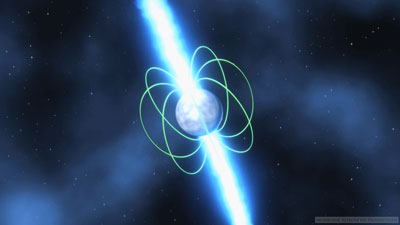| May 06, 2014 |
Astronomers harness the galaxy's biggest telescope to make most precise measurement of spinning star (w/video)
|
|
(Nanowerk News) An international team of astronomers has made a measurement of a distant neutron star that is one million times more precise than the previous world’s best ("50 picoarcsec astrometry of pulsar emission").
|
|
The researchers were able to use the interstellar medium, the ‘empty’ space between stars and galaxies that is made up of sparsely spread charged particles, as a giant lens to magnify and look closely at the radio wave emission from a small rotating neutron star.
|
|
This technique yielded the highest resolution measurement ever achieved, equivalent to being able to see the double-helix structure of our genes from the Moon!
|
 |
| The densely packed matter of a pulsar spins at incredible speeds, and emits radio waves that can be observed from Earth, but how neutron stars emit these waves is still a mystery. (Image: Swinburne Astronomy Productions/CAASTRO)
|
|
“Compared to other objects in space, neutron stars are tiny – only tens of kilometres in diameter – so we need extremely high resolution to observe them and understand their physics,” Dr Jean-Pierre Macquart from the Curtin University node of the International Centre for Radio Astronomy Research (ICRAR) in Perth said.
|
|
Dr Macquart, a member of the ARC Centre of Excellence for All-sky Astrophysics (CAASTRO), said neutron stars were particularly interesting objects to study, as some of them – called pulsars – gave off pulsed radio waves whose beams swept across telescopes at regular intervals.
|
|
“More than 45 years since astronomers discovered pulsars, we still don’t understand the mechanism by which they emit radio wave pulses,” he said.
|
|
The researchers found they could use the distortions of these pulse signals as they passed through the turbulent interstellar medium to reconstruct a close in view of the pulsar from thousands of individual sub-images of the pulsar.
|
|
“The best we could previously do was pointing a large number of radio telescopes across the world at the same pulsar, using the distance between the telescopes on Earth to get good resolution,” Dr Macquart said.
|
|
The previous record using combined views from many telescopes was an angular resolution of 50 microarcseconds, but the team - led by Professor Ue-Li Pen of the Canadian Institute of Theoretical Astrophysics and a CAASTRO Partner Investigator - has now proven their ‘interstellar lens’ can get down to 50 picoarcseconds, or a million times more detail, resolving areas of less than 5km in the emission region.
|
|
|
|
A spinning neutron star emitting a stream of radio waves that appear as regular pulses when observed from Earth.
|
|
“Our new method can take this technology to the next level and finally get to the bottom of some hotly debated theories about pulsar emission,” Professor Pen said.
|
|
Testing their technique on pulsar B0834+06, the researchers found the neutron star’s emission region was much smaller than previously assumed and possibly much closer to the star’s surface – which might be the most crucial element in understanding the origin of the radio wave emission.
|
|
“What’s more, this new technique also opens up the possibilities for precise distance measurements to pulsars that orbit a companion star and ‘image’ their extremely small orbits – which is ultimately a new and highly sensitive test of Einstein’s theory of General Relativity,” Professor Pen said.
|
|
The Australian Research Council has awarded Dr Jean-Pierre Macquart and Prof Ue-Li Pen $344,000 in research funding to continue to develop their technique and measure other pulsars.
|

